ASM Metals HandBook Vol. 17 - Nondestructive Evaluation and Quality Control
Подождите немного. Документ загружается.

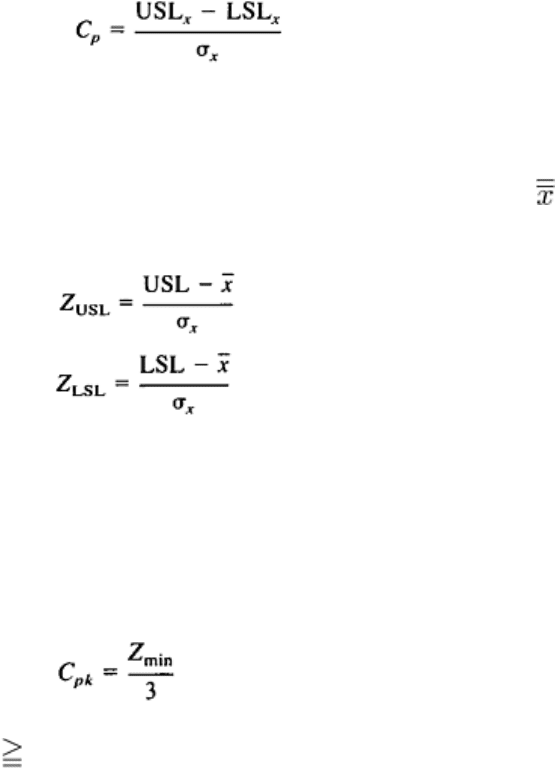
(Eq 10)
The minimum acceptable value for C
p
is considered to be 6.
Recently, many companies have begun to use a capability index referred to as C
pk
. For bilateral specifications, C
pk
is
defined in the following manner. First, the relationship between the process mean and the specification limits in the
units of standard deviations is determined:
(Eq 11a)
(Eq 11b)
Then the minimum of these two values is selected:
Z
min
= min[Z
USL
, - Z
LSL
]
(Eq 12)
The C
pk
index is then defined by dividing this minimum value by 3:
(Eq 13)
Commonly, C
pk
must be 1.00.
Statistical Process Control and the Statistical Tolerance Model
The issue of part tolerancing and, in particular, the statistical assignment and assessment of tolerances are excellent
examples of the need for design and manufacturing to understand what each other is doing and why. The best intentions
of the design process can go unmet if the manufacturing process is not operated in a manner totally consistent with design
intent. To more clearly appreciate the marriage of thinking that must exist between the design and manufacturing worlds,
some of the basic assumptions of the tolerancing activity and their relationship to the manufacturing process will be
examined. The following sections clearly point to the importance of statistical process control relative to the issue of
process capability.
The key concepts in statistical tolerancing are:
• The use of a statistical distribution to represent the design characteristi
c and therefore the process output
for the product/part in question relative to the design specifications
•
The notion of random assembly, that is, random part selection from these part process distributions
when more than one part is being considered in an assembly
•
The additive law of variances as a means to determine the relationship between the variability in
individual parts and that for the assembly
To assume that the parts can be represented by a statistical distribution of measurements (and for the assumption to hold
in reality), the part processes must be in a state of statistical control. The following example illustrates the importance of
statistical process control in achieving design intent in a tolerancing problem.
Example 7: Statistical Tolerance Model for Optimum Fit of a Pin Assembly in a Hole
Machined in a Plate.

Figure 34 shows two simple parts: a plate with a hole and a pin that will ultimately be assembled to a third part but must
pass through the hole in the plate. For the assembly, it is desired for function that the clearance between the plate hole and
the pin be at least 0.015 in. but no more than 0.055 in.
Fig. 34 Machined components statistically analyzed in Example 7
. (a) Plate with hole. (b) Pin assembly.
Dimensions given in inches
To achieve the design requirement stated above, the nominal values and tolerances for the plate hole and pin were
statistically derived and are shown in Fig. 34. To arrive at these tolerances, it was assumed that:
• The parts would be manufactured by processes that behave according to the normal distribution
• The process capabilities would be at least 6σ
, the processes would be centered at the nominal values
given in Fig. 34, and the processes would be maintained in a state of statistical control
• Random assembly would prevail
If these assumptions are met, the processes for the two parts, and therefore the clearance associated with assembled parts,
would be as shown in Fig. 35, and the design intent would be met.
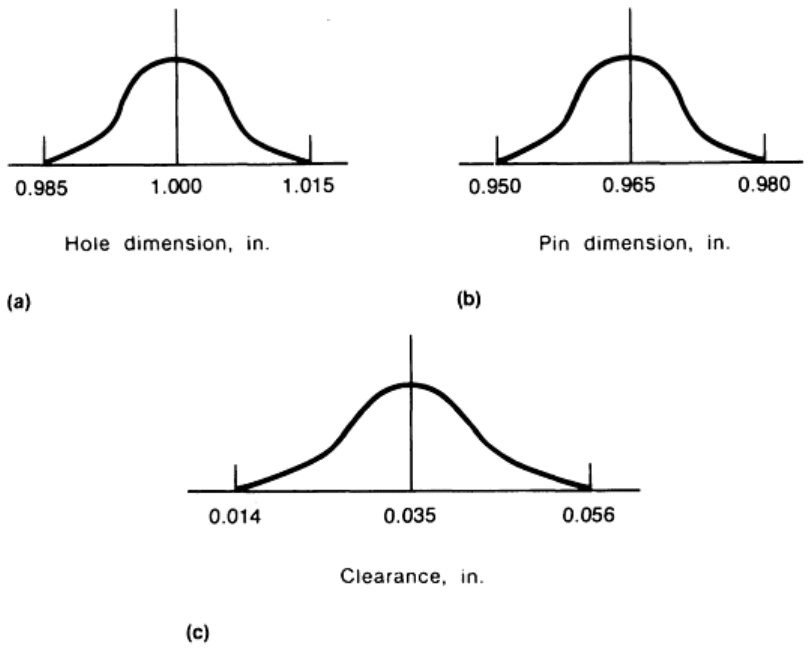
Fig. 35 Statistical basis for satisfying design intent for the hole/pin assembly clearance in Fig. 34
. (a)
Distribution of hole. (b) Distribution of pin. (c) Distribution of clearance
Suppose that despite the assumptions made and the tolerances derived, the processes manufacturing the pin and plate hole
were not maintained in good statistical control. As a result, the parts actually more nearly follow a uniform/rectangular
distribution within the specifications, as shown in Fig. 36. Such could have arisen as a result of sorting or rework of a
more variable process(es), in which case the results are doubly distressing, that is, poorly fitting assemblies and increased
cost to the system.
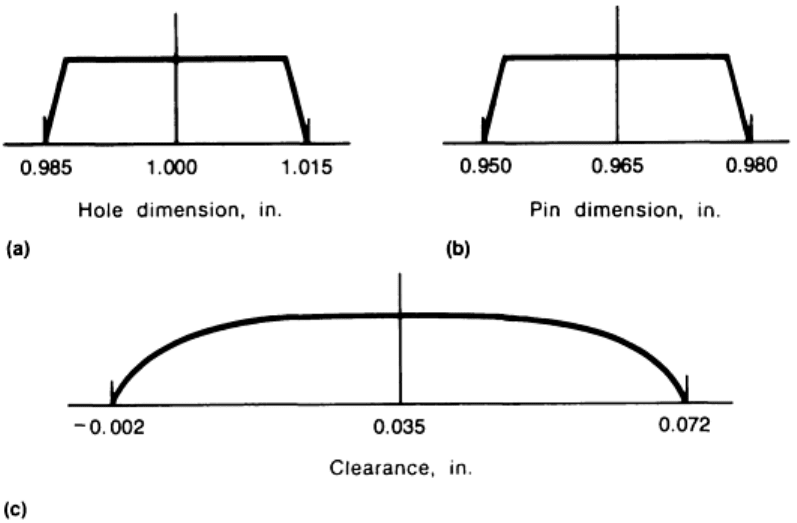
Fig. 36 Clearance implications of poor process control of plate hole and pin dimensions for components of
Fig.
34. (a) Distribution of hole. (b) Distribution of pin. (c) Distribution of clearance
Figure 36 shows the distribution of the clearance if the hole and pin dimensions follow the uniform distribution within the
specifications. The additive law of variances has been used to derive the variation in the clearance distributions but
assuming the uniform distribution for the individual part processes. Some assemblies may not go together at all, some will
fit quite tightly and may later bind if foreign matter gets into the gap, and others will fit together with a much larger
clearance than desired.
The problem here is not a design problem. The plate hole and pin tolerances have been derived using sound statistical
methods. However, if the processes are not in good statistical control and therefore not capable of meeting the
assumptions made during design, poor-quality assemblies will follow. It should be noted that the altogether too common
process appearance of a uniform distribution of measurements within the specifications can arise in several different
ways:
•
From processes that have good potential with regard to variation, but are not kept in good statistical
control
• From unstable and/or large variation processes that require sorting/rework to meet the specifications
• From processes that are intentiona
lly allowed to vary over the full range of the specifications to take
advantage locally of wide specifications relative to the process variation
In all of the three cases mentioned above, additional costs will be incurred and product quality will be eroded. Clearly,
statistical process control is crucial to the tolerancing issue in engineering design. Taguchi's loss function model, which is
an essential element in tolerance design, assumes similarly that quality characteristics can be represented by a statistical
distribution of measurements. Again, for this assumption to be met at the process and therefore in the ultimate product in
the field, the manufacturing processes must be maintained in a state of statistical control.

Statistical Quality Design and Control
Richard E. DeVor, University of Illinois, Urbana-Champaign; Tsong-how Chang, University of Wisconsin, Milwaukee
Design of Experiments: Factorial Designs
The process of product design and its associated manufacturing processes and tolerance designs often involve many
experiments to better understand the various cause-effect relationships for quality performance of the product and for ease
in process control. The sections that follow will present some of the basic concepts and methods for the planning, design,
and analysis of experiments.
The purpose of most experimental work is to discover the direction(s) of change that may lead to improvements in both
the quality and the productiveness of a product or process. Such endeavors can be referred to as process improvement
because product improvement can only be meaningfully measured through its use and that is of course a process.
Historically, design of experiments methods have tended to focus more attention on process improvement as contrasted
with product design. In this regard, the different view that might be taken toward design of experiments in product design
versus processing is probably overstated. In this section, the role of design of experiments in product design is
emphasized, as is its use in the simultaneous engineering of products and processes.
In investigating the variation in performance of a given product or process, attention focuses on the identification of those
factors that, when allowed to vary, cause performance to vary in some way. Some such factors are qualitative in nature
(categorical variables), while others are quantitative (possessing an inherent continuity of change). The situations
examined below may consider both qualitative and quantitative variables simultaneously. In fact, an important advantage
of the two-level factorial designs that will be discussed is their ability to consider both types of variables within the same
test plan.
Mathematical Model
A fundamental problem of design of experiments is that of selecting the appropriate arrangement of test points within the
space defined by the design/control and noise variables. Although many different considerations must come into play in
selecting a test plan, none can be more fundamental than the notion of the mathematical model. Whether or not explicitly
recognized as such, most experimental studies are aimed either directly or indirectly at discovering the relationship
between some performance response and a set of candidate variables influencing that response. In general, this
relationship can be written as:
Y = f(X
1
, X
2
, . . ., X
k
) + e
(Eq 14)
where Y is the response of interest, f is some unknown functional relationship, X
1
, . . ., X
k
are the independent variables,
and e is a random error. The functional form f can be thought of as a transfer function. In Taguchi's framework, the
variables X
1
, X
2
, . . ., X
k
are generally partitioned into signal, control, and noise variables.
Sometimes enough is known about the phenomenon under study to use theoretical considerations to identify the form of f.
For example, a chemical reaction can be described by a differential equation, which when solved produces a theoretical
relationship between the dependent and independent variables. More often than not, however, the knowledge is more
sparse, and empirical models must be relied upon that act as mathematical french curves describing relationships through
the data; for example:
Y = b
0
+ b
1
X
1
+ b
2
X
2
+ e
(Eq 15a)
Y = b
0
+ b
1
X
1
+ b
11
+ e
(Eq 15b)
Model Building. In most studies, the experimenter begins with a tentative hypothesis concerning the plausible model
forms that are to be initially entertained. He must then select an experimental design having the ability to produce data
that will:
• Be capable of fitting proposed model(s)
•
Be capable of placing the model in jeopardy in the sense that inadequacies in the model can be detected
through analysis
The second consideration above is of particular importance to ensure that through a series of iterations the most
appropriate model can be determined, while others may be proved less plausible through the data.
If, for example, a curvilinear relationship between temperature and reaction time in a chemical process is suspected, an
experiment that studies the process at only two temperatures will be inadequate to reveal this possibility. An experiment
with three levels of temperature would, however, allow this possibility to be considered. Figure 37 illustrates several
scenarios that emphasize the importance of the relationship between the math model and the associated design of
experiment. In Fig. 37, the following points should be noted:
• The relationship is actually curvilinear, but such will never be detected by the data
•
A poor model (straight line) has been hypothesized, but model checking can reveal this and help
propose a better model
• If the relationship is known to be a straight line, many levels
of temperature in the experiment are
unnecessary
• If it is known a priori
that the relationship is a straight line, the best test plan would be to study only two
relatively extreme levels of temperature and to use additional tests for replication to obser
ve the amount
of experimental error
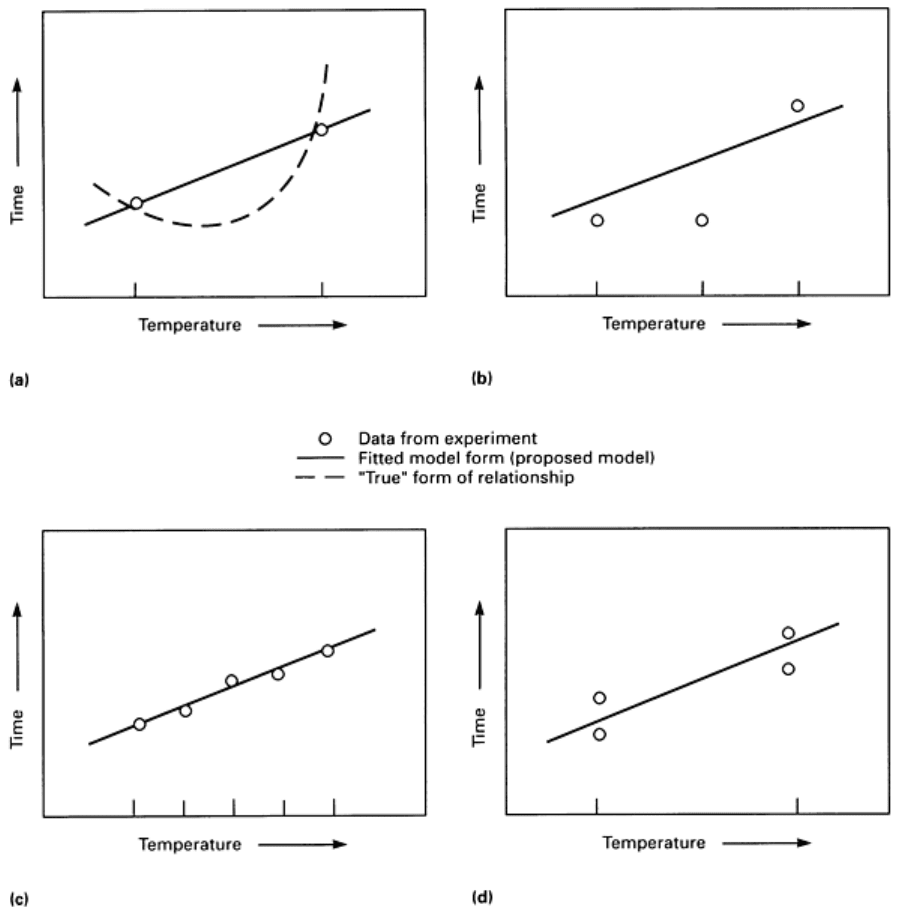
Fig. 37 Comparison of typical time-temperature relationships for true relationship (a) c
ompared to
experimental and fitted models (a through d. See text for more details.)
Sequential and Iterative Experimentation. There is always the temptation to carefully design one large
experiment that will consider all aspects of the problem at hand. Such a step is dangerous for the following reasons:
•
If erroneous decisions and hypotheses about the state of affairs are made, considerable time and
experimental resources may be wasted, and the end product may provide little useful information or
direction in terms of what to do next
• If knowledge of the underlying situation is limited a priori,
many factors may be suspected as being
important, requiring a very large experiment in terms of number of tests. Ultimately, only a small subset
of variables will be found to be of major significance
•
In the early stages of experimentation, knowledge of the specific ranges of variables that ought to be
studied is not always available. Furthermore, the metrics to be employed to define the variables,
responses, or even
what responses to observe may not always be clear in the early stages of
experimental work
•
One large experiment will necessarily cause the testing period to be protracted in time, making it more
difficult to control the forces of nuisance variation
For these reasons, it is much more desirable to conduct an experimental program through a series of smaller, often
interconnected experiments. This provides the opportunity to modify hypotheses about the state of affairs concerning the
situation at hand, to discard variables that are shown to be unimportant, to change the region of study of some or all of the
variables, and/or to define and include other measures of process performance. Experimental designs that can be
combined sequentially are very useful in this regard. This is often referred to as the sequential assembly of experimental
designs.
Revelation of Variable Effects. Often, the variables of importance are not clearly known a priori. It is desirable to be
able to study several variables together but to independently observe the effect of a change in each one of the variables.
Furthermore, it may be deemed important to know if such a variable effect varies with the conditions of the process, that
is, when other variables take on varying levels. An arrangement of the tests is called a design, which provides for the
opportunity to learn much about the relationships between the variables and the response. In particular:
• The effect of changing any of the variables alone can be observed
• The possibility th
at the effects measured above can vary as conditions of other variables vary can be
observed, that is, the existence of variable interactions
System Noise/Variation
The experimental study of any phenomenon is made difficult by the presence of noise or experimental error. Many
factors, not directly under study, are varying over the course of the experiment. These are often referred to as the forces of
common cause system variation. Such variation may cloud or mask the effect of change of the factors under study in an
experiment. The forces of noise or variation can be better understood or mitigated by several approaches, some of which
are strictly experimental design issues.
Statistical Control/Stability Analysis. If the phenomenon under study is already a viable and ongoing process, the
pursuit of improvement opportunities through experimentation can be considerably enhanced by employing the
techniques of statistical process control. In this way, spurious or sporadic sources of variation can be identified and,
through remedial action, removed. Achievement of a stable process will greatly contribute to the ability to more readily
observe the effects of purposeful process change. Thus, continued study will further enhance the ability to observe the
persistence of changes that might be introduced. Once a process is stabilized, continued attack on the common cause
system will lead to a progressively quieter process, further heightening the ability to observe the forces of purposeful
process change through experimentation.
Experimental Design Strategies. In many situations, the notion of a stable, ongoing process has little meaning. In
the early stages of product or process design or prototype or pilot-plant testing, a stable, consistent process is not present.
It is perhaps for this reason (among others) that the body of knowledge known as experimental design was cultivated.
Under such situations, the following factors are significant:
• Attempt to identify major sources of variation and take action to ensure that t
heir presence is blocked
out from the comparisons made within an experiment.
The technique of blocking is useful for this
purpose
•
Counteract the forces of unknown systematic variation over the period of the experiment by
randomization of the tests so that
such variation is uniformly and randomly distributed across the trials
conducted
•
Include replication in the experimental test plan. Multiple tests at the same conditions will provide
comparisons that directly measure the amount of variation/experimental error
•
Include confirmatory testing as part of the experimental strategy. It will be important that additional
trials are run under specific conditions determined from the analysis to verify the improvement
opportunities revealed from the experiment

The parameter design method is specifically directed at mitigating the forces of noise variation as it may be transmitted
through the product/process design to the output performance.
Nature of Variable Interactions
For many products and/or processes, the effects that the important design/control factors have on the system performance
responses of interest do not act independently of each other. That is, the effect a certain factor has on the response may be
different for different levels of a second factor. When this occurs, the two factors are said to interact or to have an
interdependency relationship; that is, a two-factor interaction effect is present. Figure 38 summarizes the nature of the
two-factor interaction effect. Figure 38(a) shows that the effect of pressure on time (the slope of the line) is the same
regardless of the level of temperature. Therefore, no interaction is present. However, in Fig. 38(b), the effect of pressure
on time is clearly seen to vary with temperature. Therefore, a two-factor interaction is present.
Fig. 38 Graphical depiction of the absence (a) and presence (b) of a two-factor interaction effect
Simple Yet Powerful Experimental Design. Many of the problems created by ad hoc testing methods and/or
methods such as the one-variable-at-a-time approach can be overcome by using an experimental design structure referred
to as the two-level factorial design. For such test plans, each factor/variable is studied over only two levels or settings, and
all possible combinations are examined. Therefore, the total number of unique tests required for such a test plan is 2
k
,
where k is the number of variables; for example, for two variables, 2
2
= 4 test conditions define the test matrix.
Figure 39 shows a graphical representation of the two-level factorial design when two and three variables are under study.
The geometric representation is useful from the standpoints of interpreting the variable effects and communicating the
purpose and results of the test plan to others. The corners of the square and the cube represent geometrically the
conditions of each unique combination of the variable settings.
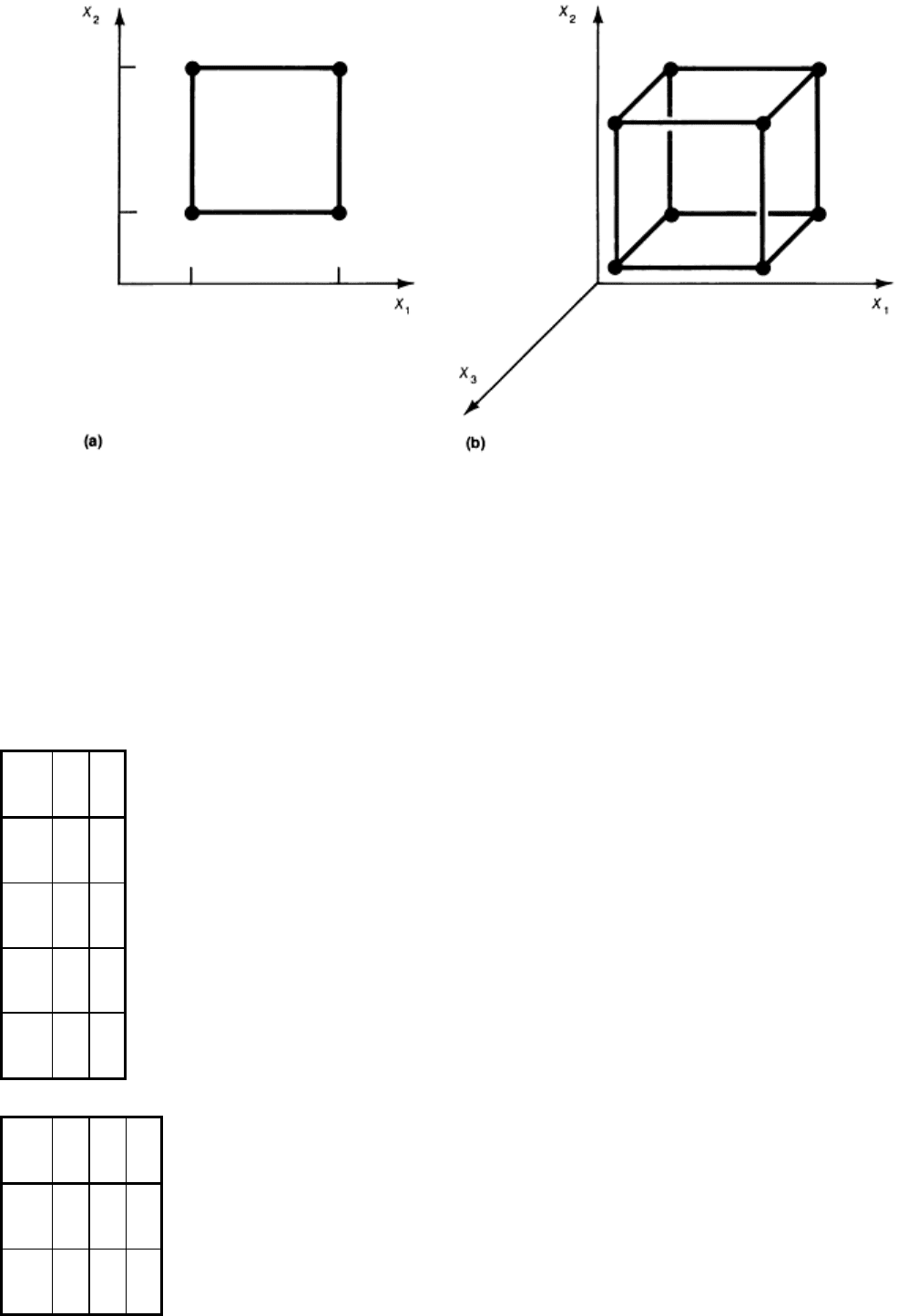
Fig. 39 Two-level factorial design for two (four tests required) (a) and three (eight tests required) (b) variables
Tables 7(a) and 7(b) provide for a more algebraic way to represent the test conditions for a two-level factorial design. The
two levels for each factor are often simply referred to as the high and low levels and are represented in coded form as + or
+1 and - or -1. This facilitates the determination of the variable effects, given the data. Each row in Tables 7(a) and 7(b)
represents the recipe for a particular test. For example, in the 2
3
factorial in Table 7(b), test 3 is run with variable 1(X
1
) at
its low level, variable 2(X
2
) at its high level, and variable 3(X
3
) at its low level.
Table 7(a) Test matrix for simple two-variable, two-level factorial design
Test
X
1
X
2
1 -
-
2 +
-
3 -
+
4 + +
Table 7(b) Test matrix for simple three-variable, two-level factorial design
Test
X
1
X
2
X
3
1 - -
-
2 + -
-
